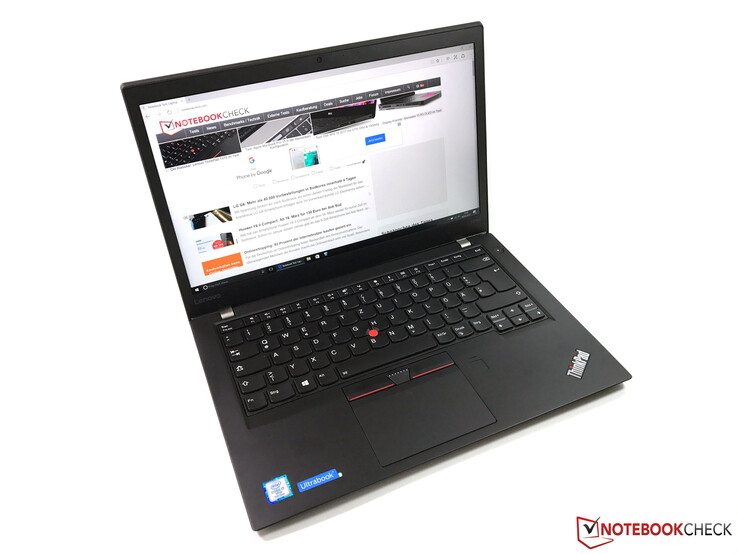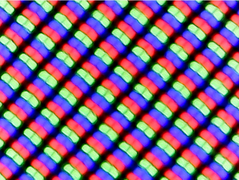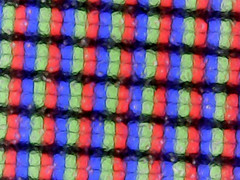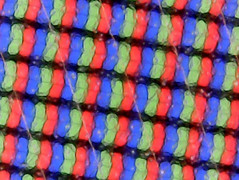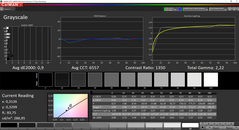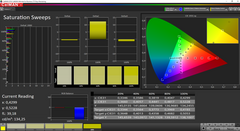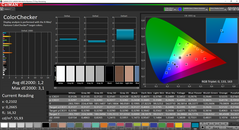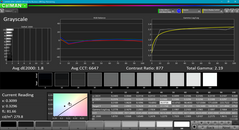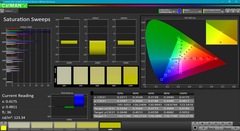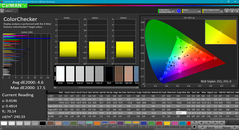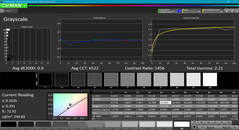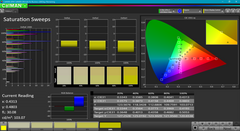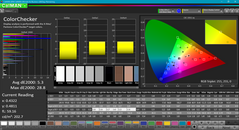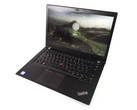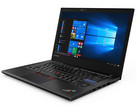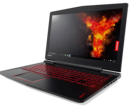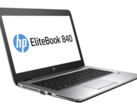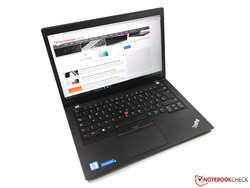Lenovo ThinkPad T470s – What is the best display option?
For the original German article, see here.
Lenovo's ThinkPad T470s is a very portable 14-inch business notebook and we have already reviewed two different SKUs. The laptops were convincing in many respects, but we also found some issues (such as temperature development, performance on battery). You also have to choose between three different display options when you want to purchase the slim business laptop. As well as a WQHD screen, there are two Full HD models (touch & non-touch). The following table shows the options with the specifications according to Lenovo.
| WQHD panel | Full HD panel | Full HD touchscreen | |
| Panel size | 14-inch | 14-inch | 14-inch |
| Resolution | 2560x1440 pixels | 1920x1080 pixels | 1920x1080 pixels |
| Technology | IPS | IPS | IPS |
| Luminance | 300 nits | 250 nits | 250 nits |
| Contrast | 700:1 | 700:1 | 700:1 |
| Surface | matte | matte | matte |
We had the chance to review all three display options for the current ThinkPad T470s. However, Lenovo still uses several suppliers and the manufacturer lists a total of eight different 14-inch panels (2x WQHD, 4x Full HD, 2x Full HD Touch) in the official parts list. The results therefore only apply for the tested panels and may deviate from other models. You will only know the exact model when you read out the panel ID and it is not visible before the purchase.
We will compare the properties of the three models in this article and also check the differences in terms of power consumption and battery runtime. We recommend our in-depth reviews of the ThinkPad T470s for additional information on the other aspects of the system:
Measurement Results WQHD
| |||||||||||||||||||||||||
Brightness Distribution: 88 %
Center on Battery: 323 cd/m²
Contrast: 1308:1 (Black: 0.25 cd/m²)
ΔE ColorChecker Calman: 6.1 | ∀{0.5-29.43 Ø4.77}
ΔE Greyscale Calman: 8.8 | ∀{0.09-98 Ø5}
94.88% sRGB (Argyll 1.6.3 3D)
61.56% AdobeRGB 1998 (Argyll 1.6.3 3D)
69.6% AdobeRGB 1998 (Argyll 3D)
95.1% sRGB (Argyll 3D)
69% Display P3 (Argyll 3D)
Gamma: 2.18
CCT: 6172 K
Measurement Results Full HD
| |||||||||||||||||||||||||
Brightness Distribution: 87 %
Center on Battery: 290.1 cd/m²
Contrast: 645:1 (Black: 0.45 cd/m²)
ΔE ColorChecker Calman: 6.6 | ∀{0.5-29.43 Ø4.77}
ΔE Greyscale Calman: 5.9 | ∀{0.09-98 Ø5}
57.3% sRGB (Argyll 1.6.3 3D)
36.4% AdobeRGB 1998 (Argyll 1.6.3 3D)
Gamma: 2.17
CCT: 7873 K
Measurement Results Full HD Touch
| |||||||||||||||||||||||||
Brightness Distribution: 88 %
Center on Battery: 271.6 cd/m²
Contrast: 1132:1 (Black: 0.24 cd/m²)
ΔE ColorChecker Calman: 6.1 | ∀{0.5-29.43 Ø4.77}
ΔE Greyscale Calman: 3.4 | ∀{0.09-98 Ø5}
60% sRGB (Argyll 1.6.3 3D)
38% AdobeRGB 1998 (Argyll 1.6.3 3D)
Gamma: 2.12
CCT: 6077 K
Display
Two things stand out when we look at Lenovo's specifications. First, the numbers for the luminance and the contrast are pretty conservative. These are minimum numbers, which should be reached by every panel (also from different suppliers). It can therefore happen that a panel clearly surpasses the values.
The second aspect is the color gamut, because Lenovo does not specify it at all. Therefore, the results may not be particularly good, so the displays will probably not be the best options for picture editing.
The default SKU in Lenovo's online shop is equipped with the matte Full HD screen. The touchscreen is available for an additional $80 and the WQHD screen currently costs $160.
We start with the two Full HD models. Both the non-touch (2nd column in the comparison tables) as well as the touch model (3rd column in the comparison table) exceed the advertised luminance, but average results of ~270 nits or ~260 nits, respectively, are still not very good for a premium product. We can see big differences in terms of black value as well as the contrast. While the regular Full HD model even misses the advertised value at 645:1 (0.45 cd/m²), the touchscreen manages very good 1132:1. For comparison: The two Full HD panels in the ThinkPad T470 as well as the ThinkPad X1 Carbon 2017 are a bit brighter and often manage better results in the other disciplines, too.
The high-resolution WQHD screen performs better in our measurements. The advertised luminance is surpassed at 311 nits on average, and the contrast is also very good at 1300:1.
Only the touchscreen model of the T470s uses PWM regulation for to control the brightness. We can measure a flickering at 219 Hz as soon as the maximum luminance is reduced. The frequency is comparatively low and could cause problems for sensitive users (such as visible flickering).
| Lenovo ThinkPad T470s-20HGS00V00 Intel Core i7-7600U, B140QAN01.5, 2560x1440 | Lenovo ThinkPad T470s 20HF-0011US Intel Core i5-7300U, ID: Len40A9, Name: LP140WF6-SPB6, 1920x1080 | Lenovo ThinkPad T470s-20HF0012US Intel Core i5-7300U, LEN40A9 (R140NWF5 R1), 1920x1080 | Lenovo ThinkPad T470-20HD002HGE Intel Core i5-7200U, N140HCA-EAB, 1920x1080 | Lenovo ThinkPad X1 Carbon 2017-20HQS03P00 Intel Core i7-7500U, B140HAN03_1, 1920x1080 | |
|---|---|---|---|---|---|
| Display | -42% | -40% | -38% | -10% | |
| Display P3 Coverage (%) | 69 | 38.25 -45% | 40.35 -42% | 41.6 -40% | 61.4 -11% |
| sRGB Coverage (%) | 95.1 | 57.6 -39% | 60.3 -37% | 61.9 -35% | 85.9 -10% |
| AdobeRGB 1998 Coverage (%) | 69.6 | 39.52 -43% | 41.72 -40% | 43.06 -38% | 62.4 -10% |
| Response Times | 25% | 6% | -4% | 0% | |
| Response Time Grey 50% / Grey 80% * (ms) | 46.4 ? | 27.6 ? 41% | 40.8 ? 12% | 41.6 ? 10% | 41.6 ? 10% |
| Response Time Black / White * (ms) | 28.8 ? | 26.4 ? 8% | 28.8 ? -0% | 34 ? -18% | 31.6 ? -10% |
| PWM Frequency (Hz) | 219.3 ? | ||||
| Screen | -27% | -19% | -11% | 4% | |
| Brightness middle (cd/m²) | 327 | 290.1 -11% | 271.6 -17% | 306 -6% | 311 -5% |
| Brightness (cd/m²) | 311 | 272 -13% | 264 -15% | 287 -8% | 288 -7% |
| Brightness Distribution (%) | 88 | 87 -1% | 88 0% | 88 0% | 85 -3% |
| Black Level * (cd/m²) | 0.25 | 0.45 -80% | 0.24 4% | 0.3 -20% | 0.24 4% |
| Contrast (:1) | 1308 | 645 -51% | 1132 -13% | 1020 -22% | 1296 -1% |
| Colorchecker dE 2000 * | 6.1 | 6.6 -8% | 6.1 -0% | 6.2 -2% | 5.5 10% |
| Colorchecker dE 2000 max. * | 12.2 | 19.1 -57% | 28.6 -134% | 13.6 -11% | 9 26% |
| Greyscale dE 2000 * | 8.8 | 5.9 33% | 3.4 61% | 5.8 34% | 6.2 30% |
| Gamma | 2.18 101% | 2.17 101% | 2.12 104% | 2.04 108% | 2.02 109% |
| CCT | 6172 105% | 7873 83% | 6077 107% | 6277 104% | 5950 109% |
| Color Space (Percent of AdobeRGB 1998) (%) | 61.56 | 36.4 -41% | 38 -38% | 39.62 -36% | 55.96 -9% |
| Color Space (Percent of sRGB) (%) | 94.88 | 57.3 -40% | 60 -37% | 61.44 -35% | 85.77 -10% |
| Total Average (Program / Settings) | -15% /
-23% | -18% /
-20% | -18% /
-15% | -2% /
0% |
* ... smaller is better
All three IPS displays have comparatively high color deviations ex-works, but the touchscreen in particular performs well in terms of grayscale. The color temperatures and the gamma values could also be closer to their respective ideal values. All three panels benefit from a calibration; the corresponding icc-profiles are available for download in the boxes on the right. The two FHD screens still suffer from high color deviations after the calibration. The high-resolution WQHD panel manages the best results in general.
There are also big differences in terms of the color gamut. The two Full HD models clearly fall behind at ~60% sRGB or 40% AdobeRGB, respectively, so they are not suitable for professional graphics or picture editing. Lenovo shows that it can use better Full HD panels with the current ThinkPad X1 Carbon, which covers the smaller sRGB standard by 85%. Professional users should use external monitors with these two models of the T470s. The WQHD screen of the T470s performs better and almost covers sRGB completely.
All three panels benefit from the matte surface outdoors. There are no problems in the shade, but the Full HD models in particular could have more powerful background illuminations to ensure a more comfortable experience in bright environments. The viewing angle stability is no problem thanks to the IPS technology.
Because of these measurements, we recommend the high-resolution WQHD panel for the ThinkPad T470s. It just offers superior picture quality (also subjectively) and manages better luminance results.
Power Consumption
We can only see small differences between the three models in our consumption measurements. However, the minimum consumption of the FHD model is comparatively high. This laptop is also on par with the WQHD panel at the highest luminance. All in all, the T470s with the touchscreen is the most efficient device under light workloads.
The other components obviously have an effect on the consumption when you stress the systems. There are differences, but all three models are pretty similar in general.
| Lenovo ThinkPad T470s-20HGS00V00 51 Wh, Intel Core i7-7600U | Lenovo ThinkPad T470s 20HF-0011US 51 Wh, Intel Core i5-7300U | Lenovo ThinkPad T470s-20HF0012US 51 Wh, Intel Core i5-7300U | Lenovo ThinkPad T470-20HD002HGE 48 Wh, Intel Core i5-7200U | Lenovo ThinkPad X1 Carbon 2017-20HQS03P00 57 Wh, Intel Core i7-7500U | |
|---|---|---|---|---|---|
| Power Consumption | -6% | 12% | 29% | 10% | |
| Idle Minimum * (Watt) | 4.64 | 6.4 -38% | 4.8 -3% | 3.21 31% | 3.84 17% |
| Idle Average * (Watt) | 8.93 | 8.8 1% | 6.6 26% | 6.15 31% | 6.3 29% |
| Idle Maximum * (Watt) | 9.12 | 9.4 -3% | 7 23% | 6.82 25% | 8.6 6% |
| Load Average * (Watt) | 42.2 | 39.9 5% | 39.2 7% | 28.5 32% | 41.9 1% |
| Load Maximum * (Watt) | 47.3 | 45.3 4% | 44.8 5% | 34.5 27% | 48.7 -3% |
* ... smaller is better
Battery Runtime
All three ThinkPad T470s test models use the same battery configuration with two internal modules and a total capacity of 51 Wh. We only compare the realistic Wi-Fi test (Balanced power profile) at an adjusted luminance of 150 nits for this article.
The T470s WQHD manages the lowest runtime of the three at almost 7 hours, which is not surprising. The regular Full HD model lasts about 30 minutes longer, the T470s with the touchscreen a further 30 minutes longer. The result of the touchscreen version might be surprising at first due to the similar display specs, but we can see the results of the PWM regulation here. The background illumination is turned off and on periodically, which saves a bit of power. One of the Full HD models is therefore the better choice if you need the longest battery runtime possible.
| Lenovo ThinkPad T470s-20HGS00V00 2560x1440, 51 Wh | Lenovo ThinkPad T470s 20HF-0011US 1920x1080, 51 Wh | Lenovo ThinkPad T470s-20HF0012US 1920x1080, 51 Wh | Lenovo ThinkPad T470-20HD002HGE 1920x1080, 48 Wh | Lenovo ThinkPad X1 Carbon 2017-20HQS03P00 1920x1080, 57 Wh | |
|---|---|---|---|---|---|
| Battery runtime | |||||
| WiFi v1.3 (h) | 7 | 7.6 9% | 8.1 16% | 7.3 4% | 8.3 19% |
Verdict
Lenovo still equips expensive business laptops like the ThinkPad T470s with mediocre Full HD screens. There is a trend towards higher resolution panels (often with better characteristics), but there are much better Full HD panels on the market. This is impressively shown by the Asus ZenBook UX3410, for example.
The panel lottery is another problem, because Lenovo uses several suppliers. You therefore never know the exact display you will get and whether you will be confronted with PWM flickering (like on our touchscreen model). All in all, the high-resolution WQHD panel leaves a much better impression compared to its FHD counterparts. It is brighter, has a wider color gamut as well as more accurate colors after a calibration.
You will have to get the high-resolution WQHD panel for the best possible picture quality on the ThinkPad T470s. The effects on the battery runtime are not that big.
The Full HD models manage slightly longer battery runtimes (which is also influenced by the PWM regulation) as well as the lower price. Currently, Pre-configured (Top seller) models are mainly equipped with FHD panels, but the system can be customized in Lenovo's online shop and the WQHD panel is a $160 option. This is certainly no bargain. If you want to enjoy the best picture quality, however, it is a necessary upgrade.





